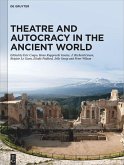Figurines exhibiting a distorted appearance were exceptionally à la mode in the Hellenistic and Roman periods. Archaeologists have attributed a wide gamut of functions to them. The underlying common denominator of all the propounded theories is that the purpose of these images was the lampoon and degradation of the dregs of society and of the physically deformed. This book argues that such statuettes conversely carried deeply positive meanings.
"Pour conclure, cet ouvrage dense met en lumière tout un trésor d'images difficiles à appréhender, tant du point de vue de l'iconographie, du contexte archéologique que de la réception. Malgré les réserves exprimées, on ne peut que recommander la lecture de ce livre."
Estelle Galbois in: BMCR 2023.06.37 (https://bmcr.brynmawr.edu/2023/2023.06.37)
***
"[...] this volume is a welcome contribution to the field of terracotta figurines, ancient medicine, grotesques and humour."
Alexandre G. Mitchell in: The Classical Review, Published online 2023:1-2 (http://doi.org/10.1017/S0009840X23001683)
***
"Der vorliegende Band ist unbedingt lesens- und vor allem bedenkenswert. Eine flotte, saloppe, teils provokante Sprache sowie die schnelle Aufeinanderfolge von neuen Objekten und Informationen fordern zu einer intensiven und konzentrierten Lektüre zu diesem weitläufigen Thema auf."
Frank Hildebrandt in: Göttinger Forum für Altertumswissenschaft 26 (2023) (https://doi.org/10.14628/gfa.2023.1.104041)
Estelle Galbois in: BMCR 2023.06.37 (https://bmcr.brynmawr.edu/2023/2023.06.37)
***
"[...] this volume is a welcome contribution to the field of terracotta figurines, ancient medicine, grotesques and humour."
Alexandre G. Mitchell in: The Classical Review, Published online 2023:1-2 (http://doi.org/10.1017/S0009840X23001683)
***
"Der vorliegende Band ist unbedingt lesens- und vor allem bedenkenswert. Eine flotte, saloppe, teils provokante Sprache sowie die schnelle Aufeinanderfolge von neuen Objekten und Informationen fordern zu einer intensiven und konzentrierten Lektüre zu diesem weitläufigen Thema auf."
Frank Hildebrandt in: Göttinger Forum für Altertumswissenschaft 26 (2023) (https://doi.org/10.14628/gfa.2023.1.104041)







